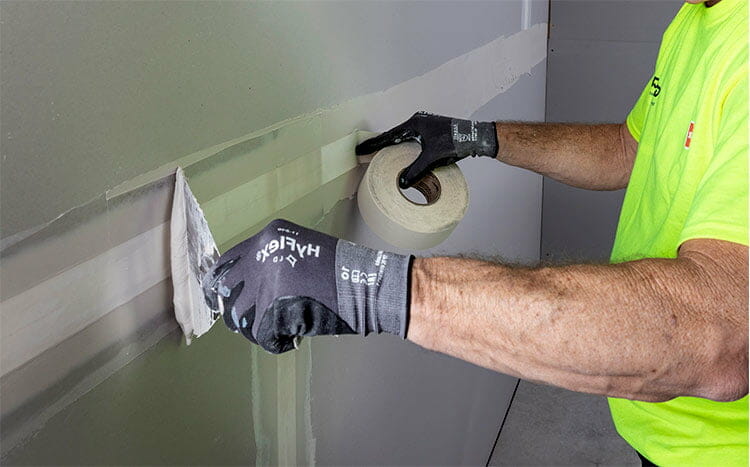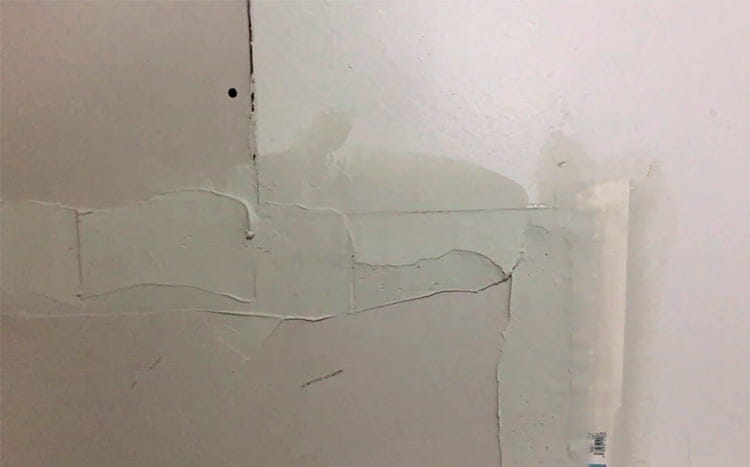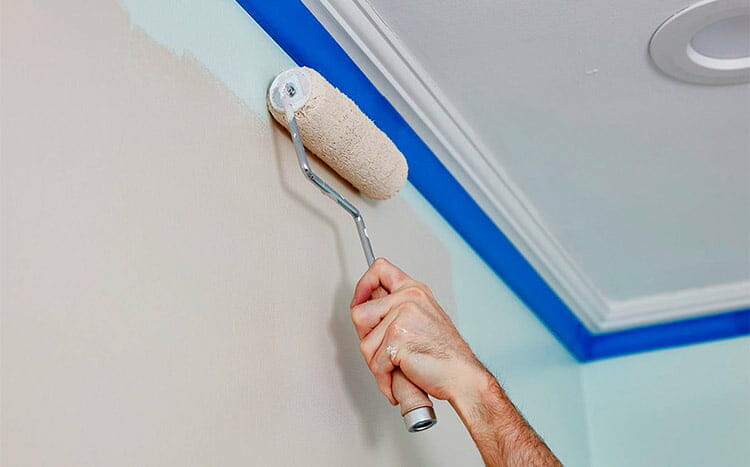Applying mud to drywall represents a cost-efficient and simple strategy for refinishing and repairing drywall surfaces. Taping is a key component in the mudding process, but is skipping it an option?
Yes, you can mud drywall without taping. This is because taping only reinforces the joint, seam, or repair work. And while it helps in terms of reducing the odds of premature cracking, it is possible to seal a seam or a joint without taping. You can just use the joint compound directly and it will work.
Here is what you should know about mudding and taping drywall.
Is taping necessary for drywall?
Taping is necessary to strengthen drywall joints and seams. It does so by providing a cohesive and flexible bond that can withstand a higher level of strain. This increases the lifespan of the joints or seams.
Therefore, taping drywall with drywall paper tape, fiberglass mesh tape, metal tape, or vinyl composite tape is necessary if you want to create better drywall joints and seams.

What can I use instead of drywall tape?
You can use the following instead of drywall paper tape.
Fiberglass mesh tape
Fiberglass mesh drywall tape is an alternative that most beginners and DIY enthusiasts prefer.
It is easy to install. This is because it has a sticky surface that does away with the need to sandwich it between joint compound coats.
And while drywall paper tape offers better flexibility and strength, the fact that fiberglass mesh tape is easy to install, and has a higher degree of mold resistance is usually enough to endear it to the average person.
Metal tape
Drywall tape isn’t the perfect material for sealing outside joints that are wide-angled. If you want to create a stronger joint, the metal tape will provide the perfect solution.
Most professionals prefer sandwiching it between drywall joint compound layers as the preferred method of finishing wide-angle joints because of its affordability and how easy it is to use.
Vinyl composite tape
Vinyl composite paper is a modern alternative to traditional drywall paper. And even though it is pricier, it is an attractive option because of its ability to form sharp and clean angles.
Do you tape drywall before mudding?
When using fiberglass mesh tape or fiberglass mat tape, you can tape the drywall first before applying the mud. This is because these types of tapes contain an adhesive that will allow the tape to stick to the drywall. Therefore, you won’t need to apply the initial coat.
However, if you are using drywall paper tape, you will need to start by applying joint compounds to the seams. Thereafter, you can then apply the paper tape, before finally applying the subsequent mudding coats of joint compound.

How do you finish drywall without taping it?
You can finish drywall without taping it by taking advantage of other finishing techniques. Here are the most effective ones.
- Crown molding. Crown molding is effective at enhancing a room’s beauty. But that is not all that it can do. If you don’t want to paper tape and mud your drywall, you can use crown molding to hide seams and gaps. This is so especially for those that are located at the meeting points of an existing drywall ceiling and walls.
- Caulking. Caulking is also a viable alternative to taping and mudding. This is because when the caulk is applied to seams and other gaps in the drywall, it seals them off. And while it is not as effective as mudding and taping, it is better than leaving the seams and joints uncovered.
- Horizontal drywall installation. You can also avoid having to mud and tape drywall by installing the drywall sheets horizontally. This will leave you with a horizontal seam that can be easily covered by a chair rail. Evenly-spaced vertical boards can then be used to cover any resultant vertical drywall seams.
- Using quarter rounds in corners. They work because they can easily be blended with the drywall. This is because they are generally small in size. And they can also be painted with the same color as the drywall.
Is mesh or paper tape better for drywall?
Paper tape is better for drywall because it provides better flexibility and strength than mesh tape. However, since mesh tape comes with a sticky side, it is ideal for beginners simply because it is easier to apply.
Can I use painter’s tape instead of drywall tape?
No, you shouldn’t use painter’s tape to tape drywall.
This is because the painter’s tape is not porous. As a result, it won’t allow drywall mud to seep through it. This completely diminishes its ability to enhance the strength and durability of the mud-drywall bond.
Therefore, using painter’s tape will still leave drywall seams and joints vulnerable to premature cracking, especially when the joint compound shrinks.
Should I sand between coats of drywall mud?
It is not necessary to sand between coats of mud.
The only time that you may have to do this is if there are bumps in the underlying coat. But if you remove any excess compound, right after you apply wet joint compound, and then even it out with a putty knife before it dries up, sanding will be unnecessary.
How to mud drywall
The following are the steps that you should follow when mudding drywall.
Step 1: Cover your floors
Cleaning mud splatters off your floor can be a headache. To avoid the hassle of having to clean your floors after you are done mudding your wall, it is usually advisable that you shield them. Do so using canvas drop cloths.
Step 2: Apply mud to the joint
Scoop a small amount of drywall compound with a taping knife and then apply it to the joints. Spread it evenly until it fills up the joint.
Step 3: Remove excess mud
When trying to work the drywall compound into the joint, some of it will stick out. Wipe this mud away to make sure that you have an even surface.
Step 4: Apply tape to the joint
Before the wet joint compound dries out, cut out some drywall paper tape and apply it over the wet joint compound. And if after applying the tape you notice bubbles forming, use the taping knife to smooth them off.
Step 5: Apply more mud
Give the first coat of mud time to dry up. And after it does, use the knife to apply a thin mud coat over the tape. And if there is any excess mud, wipe it off as before. The goal is to create an evenly spread thin coat of mud.
Step 6: Apply the last coat of mud
After the second coat dries, it is now time to apply the finishing coat. Use a wider knife — a 10-inch knife will do — as it will make it easier to make this layer as thin as possible.
Step 7: Sand
After the last coat dries, the drywall wall joint will now be ready for smoothening. To do so, you will have to sand the area.
For this stage, you can either use a power drywall sander or a drywall pole sander. And whichever tool you choose, the goal should be to even out the taped and mudded area until the drywall surface is smooth and even.
FAQ's
If you are using drywall paper tape, you mud first. But if you are using fiberglass mesh tape, you tape first before you apply wet joint compound.
You only need 3 coats of mud. You will apply the first coat to fill up the gap in the joint and as an adhesive base for drywall tape. You will apply the second one to secure the tape, drywall, and the first coat in place. And the third one will be the finishing coat.
No, it is not difficult to tape drywall. In fact, you can do the taping on your own, without having to rely on a professional contractor.
If you are using drywall paper tape, you simply apply the joint compound in the seam, place the tape over the seam before applying subsequent coats of joint compound. And if you are using fiberglass mesh tape, you simply apply the tape on the seam and then apply the joint compound thereafter.
Paper drywall tape sticks best to drywall. However, it doesn’t come with an adhesive and so it might be a little bit challenging to use. But as far as strength and flexibility are concerned, it is way better than fiberglass mesh tape and drywall metal tape.
No, you shouldn’t use caulking instead of drywall mud. This is because caulking isn’t as good at providing the adhesion that is needed to keep drywall boards in place.
The mud simply develops a better bond with drywall sheets, and it is thus the ideal material to use.

If you need help installing drywall in your home, you should visit HomeGardenGuides.com. It offers a free service that quickly matches you with the top-voted local experts.
Using the website, you can get 3 estimates fast by real certified experts in your area in just 2 minutes. Here is how it works.
- You scroll to the top of the page and enter your Zip code.
- Answer questions about your remodeling needs
- Your details will be forwarded to three local experts.
- You will then receive a price estimate for the job and some friendly advice.
IMPORTANT: There is no obligation to hire. This is a free tool and service to be used at your pleasure.







